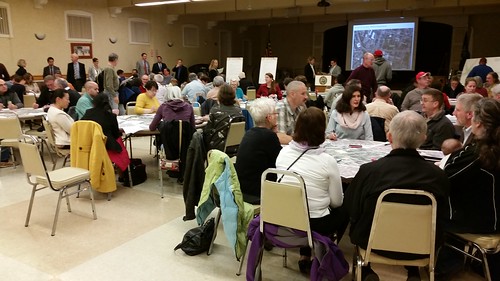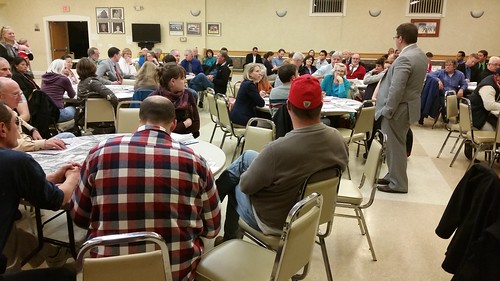Lord Overpass Meeting Report

Last evening (November 16, 2015), the city of Lowell’s Department of Planning and Development held a public meeting at the Senior Center on the Lord Overpass Redevelopment project. More than 100 residents attended. The meeting opened with remarks by City Manager Kevin Murphy, State Senator Eileen Donoghue, and State Representative Rady Mom (City Councilors Jim Milinazzo and Corey Belanger also attended the meeting).
Lowell Traffic Engineer Nicholas Bosonetto gave some history about the Lord Overpass. It was constructed in the 1950s as a highway interchange that would link the Lowell Connector to downtown. Because it was designed as a highway, there was little consideration given to pedestrians. He also said that to elevate Middlesex Street sufficiently to allow trains and vehicles on Thorndike Street to pass underneath it, Middlesex Street had to be moved closer to Appleton Street. This reduced the distance between the traffic lights on the Overpass which contributes to the vehicular congestion. Mr. Bosonetto also said that the Hamilton Canal District will bring another 750 cars per day to this area and the Judicial Center will bring 500 more.
The next speaker was Trish Donelon, a representative of the company hired by the city to do the design work for the project, explained that there are some constraints (both physical and financial) that limit what can be done. First is the railroad track that runs from the Gallagher Terminal, under the Overpass, then alongside Western Ave, is an active rail line that cannot be moved or altered. As a consequence of that, the two bridges over the tracks on Middlesex Street and Chelmsford Street must remain in place. The Pawtucket and Hamilton Canals limit much of what can be done. The final constraint is the need to keep the overpass elevated at a height that allows traffic on Thorndike Street and on the train track to pass underneath.
For the next phase of the meeting, all in attendance broke up into small work groups, each with a DPD worker as a facilitator and note taker. After about 45 minutes of small group discussion, each group have a quick summary of their top recommendations. One common suggestion was to make the overpass two-way, especially from Appleton to Chelmsford and then from the two portions of Middlesex Street. Other recommendations included creating buffer zones of street trees and shrubs between sidewalks and the road; place sidewalks on all sides of all road; make the crossings easier for pedestrians. A final recommendation was to increase police enforcement of existing traffic laws, especially those related to yielding to pedestrians.
At the conclusion of the meeting, Craig Thomas of DPD said that he, his staff, and the engineers would take all of the suggestions from the group back to the office and incorporate that information into the final design of the new overpass. He said another meeting will be scheduled in January or February 2016 so that the engineers can brief the public on the final plans.
